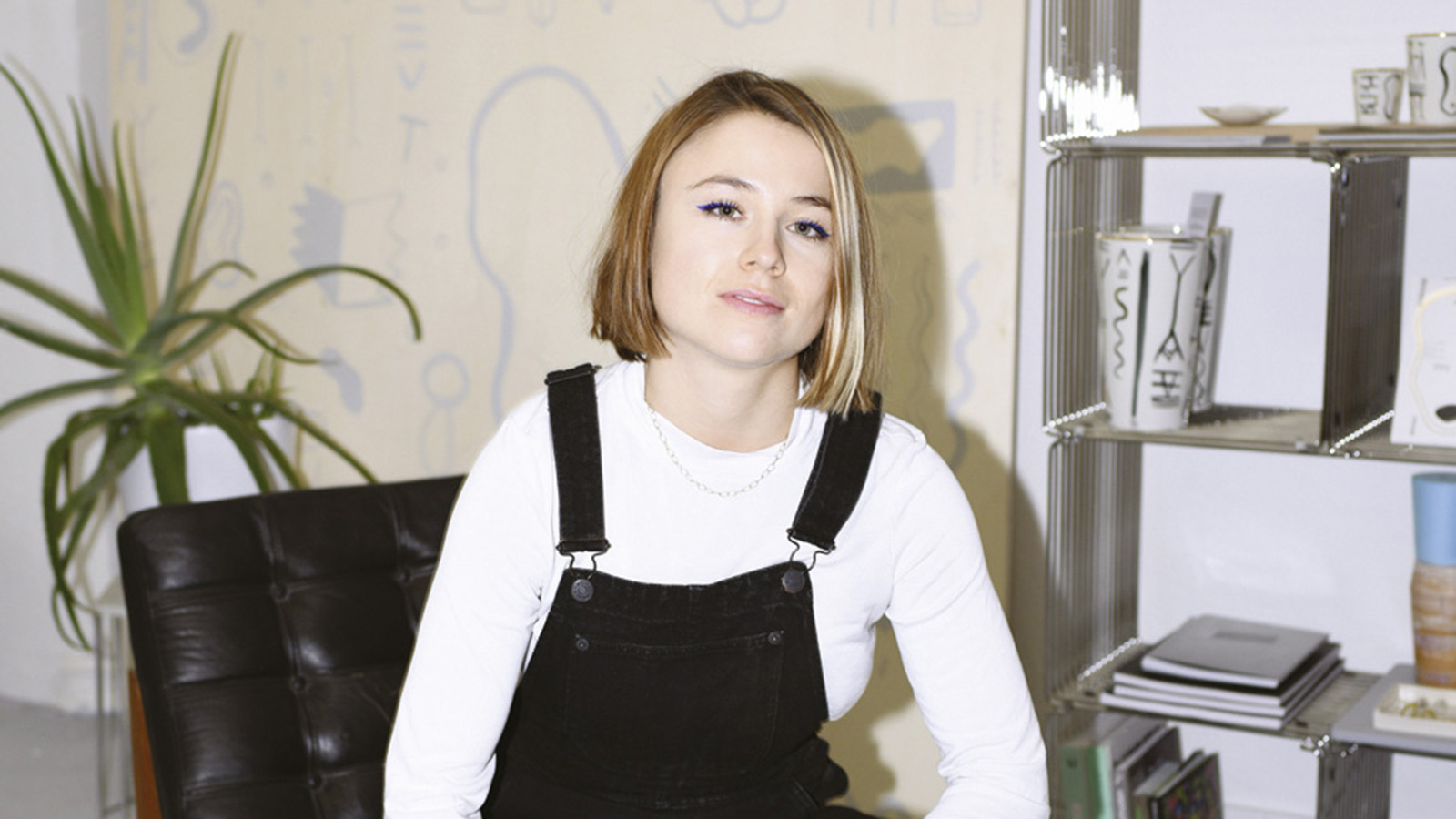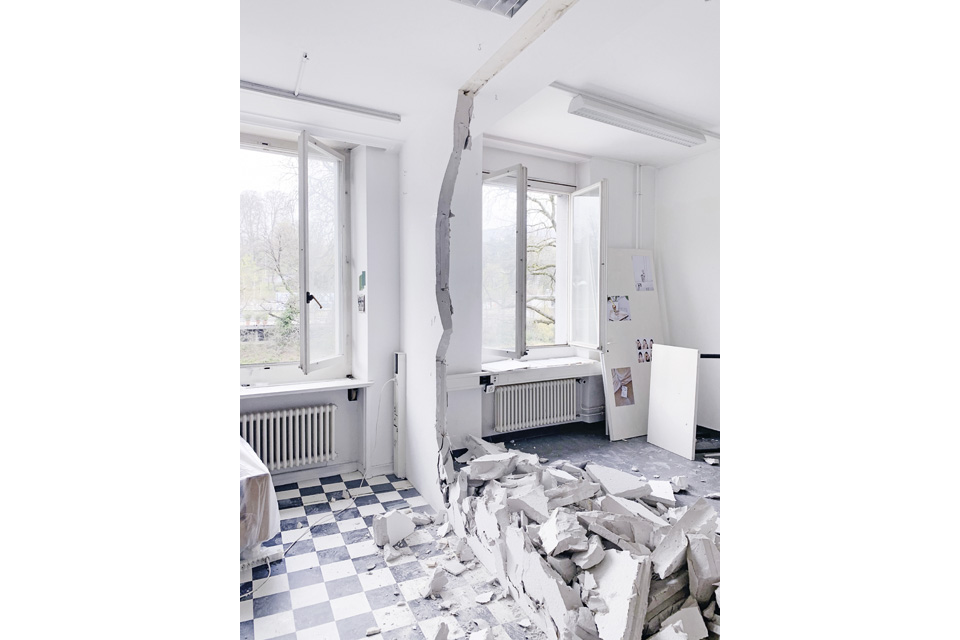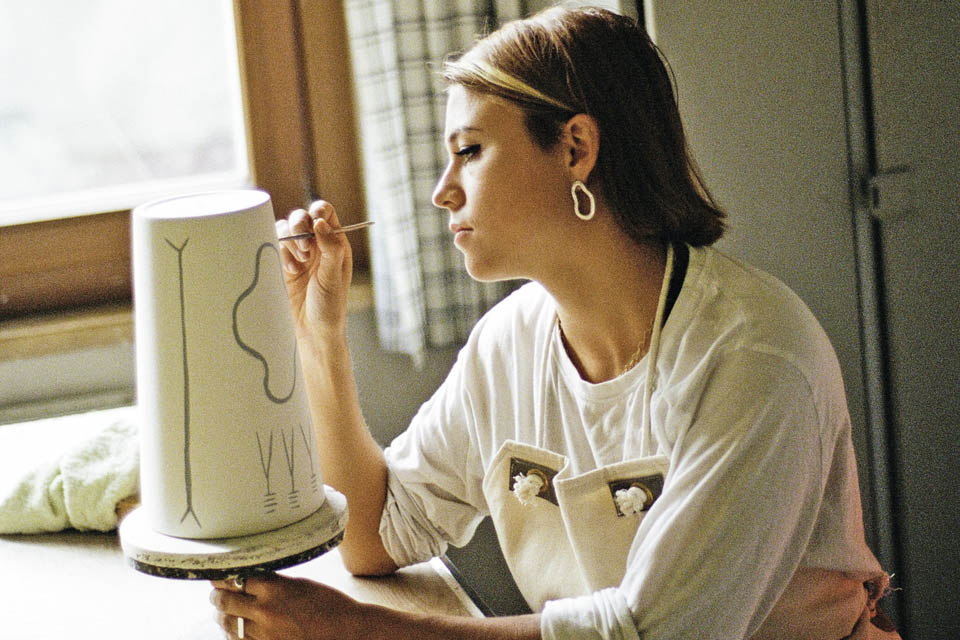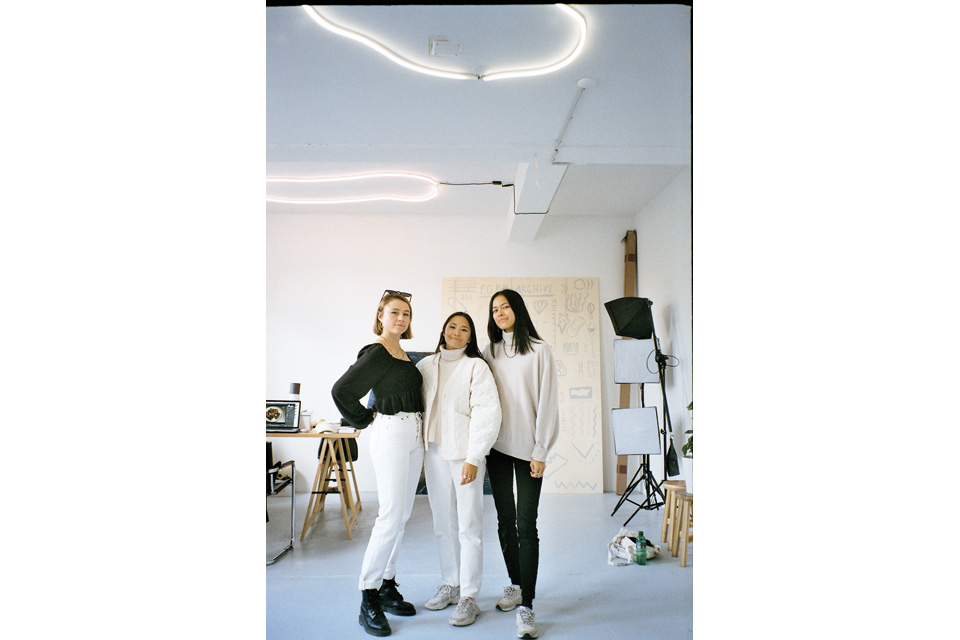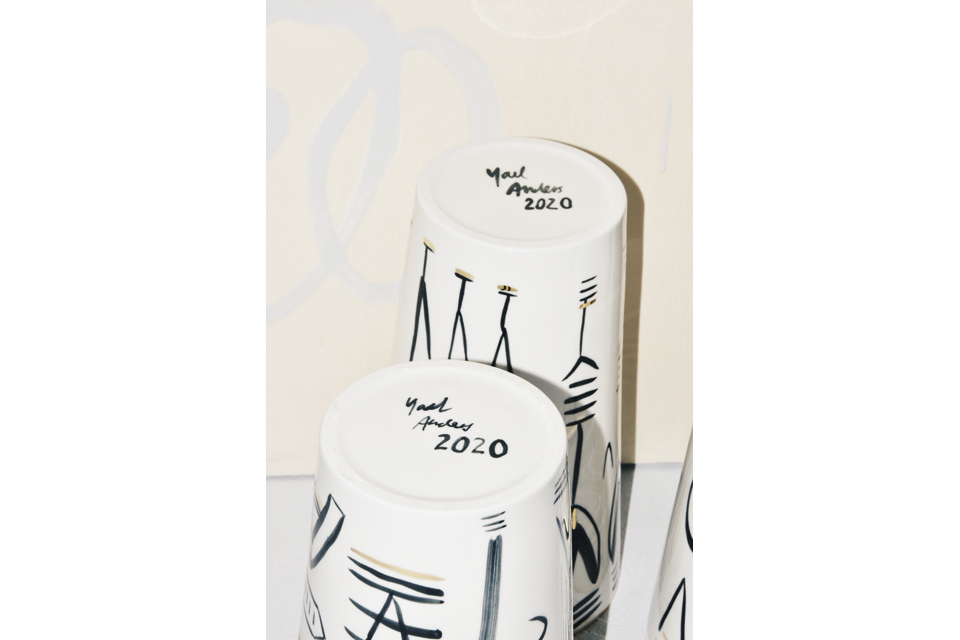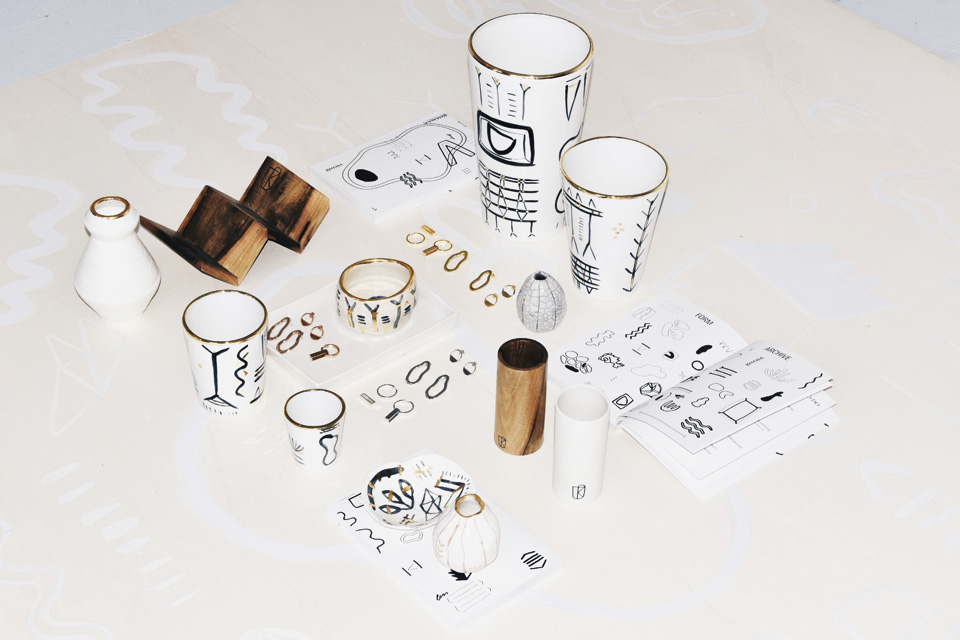Sitting still is not for Yael Anders. And why should she, when the Zurich designer has so many ideas buzzing around in her head, carrying her from project to project like Tarzan the liana through the jungle. Anders has lived in Sweden, Paris and Berlin, speaks six languages, works with ceramics, paper, textiles and wood, and exudes so much energy that we’re happy to take a few joules of it during the corona lockdown.
FACES: How did you get to where you are today?
Yael Anders: For me, the essential thing in life, as in design, is the process. During my studies at the Zurich University of the Arts and at ENSAAMA in Paris, I built up and established my creative studio in Zurich. Based on my illustrative work, I developed a small, constantly growing collection of objects. I also develop various cultural projects, including for the city of Zurich, and design various media for projects and companies. I’m very lucky at the moment, everything comes together and is easy for me. My job often doesn’t feel like work at all. I just live, and somehow projects come out of that. (laughs)
F: One of your projects is your own agenda. Where did the idea come from?
YA: At the music grammar school in Zurich, the pre-lined agendas didn’t give me enough freedom. I wanted an agenda with plenty of space for my own structures, so I designed my first edition. That was approx. 2012, and the circulation at that time was accordingly about as large as my school class. The editions became more professional every year, as I was able to bring new know-how to the project through my studies at the ZHdK. Since then, circulation has also increased somewhat, so that today several hundred people live with my agenda throughout the year. A very nice thought for me.
F: You take photographs, work with ceramics, know your way around textiles, wood and metal, create illustrations and layouts. An incredibly wide range of techniques and skills at your disposal. How do you describe your work and your profession?
YA: I am interested in haptics, material properties and the analog; craft techniques, some of which have emerged from ancient traditions. From the outside, it seems difficult to fit the various activities into a uniform field. I think that this interdisciplinary work is exactly what I find so exciting. To keep it simple and clear, I usually answer the initial question with “designer”. For me, the concept of design encompasses the process from draft to planning to a specific form of visualization. There are also characteristics of the concept of design that I don’t quite agree with. Design often involves a very commercial orientation and product focus, which can be problematic depending on the context. But for now, I’m sticking with the title of designer – and who knows, maybe that will change very soon?
F: Which experience is the most important and which insight is the most valuable?
YA: After thirty-seven night shifts after my first ceramic collection, which triggered too many orders due to a newspaper article, I realized that “hustling” just wasn’t “the way to go”. I realized that good planning and calm action produce much better results in the long term, instead of shaping ceramics in night shifts, half of which don’t turn out well. That saves my energy, my motivation, my material and my environment. The most important realization for me is that the day doesn’t have as many hours as I have ideas, and that the process is the goal for me.
F: What is the most difficult thing about being self-employed?
YA: The most difficult thing is also the most beautiful: freedom. Setting a framework for myself and being able to plan my own everyday life in a self-determined way is an enormous empowerment for me, which also challenges me, which I like. Apart from that, I am enormously overwhelmed every year with my tax return, a Swiss administrative burden that we could very much do away with.
F: Is it easier to start your own business today with social media, YouTube and the like?
YA: The tools are new and have changed a lot with digitalization. But just like everywhere else, you have to be able to handle the tools. People who want to become self-employed are now faced with new opportunities that also present new challenges. Social media is so relevant today that for many it is also a massive overload to be specialized in the social media sector in addition to their specific activity. In addition, our labor standards are also changing. Full-time positions are increasingly seen as outdated, and new combination models between self-employment and part-time jobs are becoming established.
F: What do you think of Instagram?
YA: Instagram has become an important tool for me and fulfills a form of “means to an end.” On the one hand, the platform offers a certain form of equal opportunities, in which everyone who has access to the internet can express themselves and have the opportunity to use the platform for projects and content. Instagram is also important for networking and the exchange of political and other formations. As a young designer, Instagram has enabled me to make a lot of exciting connections and projects, and the majority of my commissions and orders are placed via this platform. On the other hand, the negative impact of Instagram on the mental health of young people is unprecedented. And it’s a problem that all social media belong to a few corporations that have an incredible amount of power as a result. They determine the framework conditions and their algorithms determine the rules we play by. I ask myself: where are the alternatives? In the early days, the internet had the potential to be used more collectively or more diversely. If there was a differently organized app with the same functions – I would switch immediately.
“The day doesn’t have as many hours as I have ideas.”
F: What do you draw inspiration from, and what do you do when the muse isn’t kissing you?
YA: My agenda serves as a collection and mobile mood board that I always have with me. I often roughly sketch shapes or ideas when I come across something interesting in everyday life. I also live in a large shared flat with people from different areas. From film to chemistry and architecture… My flatmates give me different perspectives on individual projects, which can expand them in an interdisciplinary way.
F: How has Corona affected your day-to-day work and how you think about your work?
YA : Corona has confirmed my focus on digitality and also on digital platforms, and it has become clear that a focus in these areas makes sense. I am aware that I am speaking from a very privileged perspective in many respects. I became even more aware of this during the coronavirus crisis and I tried to help others in any way I could.
F: How do you maintain your network in times of Corona?
YA: As before Corona, an important part is digital. However, my personal network has been minimized to a small but fine essence. I live in Zurich’s old town in a large, old house with a garden and thirteen flatmates.
F: What prejudice do you often face, and how do you counter it?
YA: I try not to think in prejudices myself, and so I don’t feel strongly confronted with the prejudices of others. I’m often called an “influencer” because I used social media as a platform early on, but I can take that with a sense of humor. I am also very happy that I have acquired the basics of social media skills and can accept this not entirely serious title for all the inquiries, projects and networks that arise as a result.
F: What does Zurich have that other cities don’t, and what peculiarities of the city can you get worked up about for hours?
YA: Zurich is a water city, and that’s what I love about it. We swim all the time in summer, partly because there are so many opportunities to do so – and of course also because I can organize the time myself. When I think of Zurich, I think of starry nights on the roof terrace of my shared flat and the sun rising behind the Alps over the lake. People hurrying around in the streets, hurrying about their business. And the incredibly poorly planned cycle paths… Unfortunately, Zurich has failed to establish itself as a cycling city. But in the evening, when the sun sets over the Limmat and I have an aperitif on the banks of the river, even these worries disappear.
F: Where do you like to hang out most in Zurich, and what are your favorite places?
YA: The Badi culture in this city is unique. The Frauenbadi creates important spaces and for me is one of the most beautiful oases in the city. Letten, with all its bars and cafés, is also an important place for me. Apart from that, I like the old town with its museums; the Kunsthaus and the Helmhaus are just a few steps away from my home. District five is an exciting place to discover small stores or take a gallery tour. I regularly go to the Toni Areal to attend lectures or to see an exhibition at the Museum für Gestaltung. My studio on Limmatplatz is naturally like a second home to me. When I’m not there, I’m across the river at Dynamo or somewhere else on my bike.
F: How do you describe Zurich?
YA: Zurich is cold, but beautiful.
F: How, where and from whom do you do your own shopping?
YA: I have been trying to buy second-hand exclusively for several years now. With all the flea markets and brokers in the city of Zurich, it’s not that difficult. As all stores are currently closed, more and more “Depop” parcels are landing in our letterboxes. Otherwise I love Kari-Kari, Schön & Recht, Sphères, Opia or the Landesmueum store in Zurich – of course also because I have things on display there. (laughs)
Q: What are you saving for?
YA: I would like to collectively renovate an old house with my cousins and friends. Our grandmother always dreamed of a house in the country and by chance was able to buy a large house not too far from Zurich, which was to be renovated in the meantime. We are seven cousins and have lots of ideas and plans for the house – from workshops and weekend retreats to big parties that we would like to celebrate there.
F: Your absolute favorite thing you own?
YA: My bike. After all those years of flea market bikes that were regularly stolen and spent half the time being repaired, I bought myself a solid bike a few years ago. A friend recently watched me get on the bike and said: “From the movements, it looks like you’re one with your bike.”
F: What are you particularly proud of?
YA: To my studio conversion.
F: What can’t you do?
YA: Just do nothing.
F: Are trends still up to date?
YA: The question is, were they ever contemporary? Or are phenomena already a thing of the past as soon as they are analyzed as trends and turn from macrotrends into megatrends? In contrast to earlier times, several trends exist in parallel today. The distribution and communication of trends has changed dramatically as a result of the globalized and digitalized world, and a “new” trend is everywhere within minutes wherever there is the Internet and smartphones.
F: The soundtrack of your life?
YA: “The Youth” by MGMT. I think that even at 90 I would still feel like I was a teenager.
F: Which person would you definitely like to meet one day?
YA: I would love to meet the artist Pipilotti Rist. Her feminist art was formative and impressive for me as a young woman.
F: What’s the wildest thing you’ve ever done by yourself?
YA : Relatively spontaneously, I smashed the wall in my two-room studio with a hammer. This may look like a lot of fun , but it is enormous
exhausting! I then had to carry over 986 kilos of material out of the studio by hand, but now I have more space for new things, both mentally and physically. Kim
Pham and I would like to open up the studio more for other things – workshops or happenings.
F: What time of day is the best and why?
YA: The early morning and the deep night. I start my day with coffee and a newspaper in bed, although the time varies depending on the day. I like the morning when the
day begins anew and gives me the feeling that anything is possible.
F: What adventure do you dream of?
YA: I dream of more equal opportunities and more time and space for experimentation. I think that would be an adventure for everyone.
Yael Anders: The current projects
The Agenda project: Through the medium, this is repeated annually and also defines my original approach to design.
The Collectif Mon Amour project: Together with Collectif Mon Amour, I developed an illustrative pattern design that will be on display at Modissa on Zurich’s Bahnhofstrasse from March as part of their current collection. I will also be exhibiting various handmade ceramic objects in Zurich, for which I am currently experimenting with different shapes and colors.
The Recycle-Upcycle project: I have already implemented this intercultural Recycle-Upcycle project several times together with Service Civil International and the Dynamo of the City of Zurich. For two weeks, people from different countries lived in Zurich and exchanged ideas on recycling and upcycling techniques. This results in various experiments and products made from materials that are no longer used, which are then sold in the fair fashion and eco-design store Rrrevolve in Zurich. The proceeds go to the non-profit organization Service Civil International.


